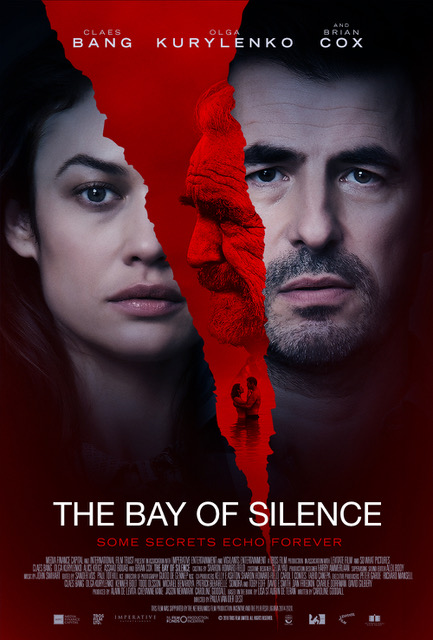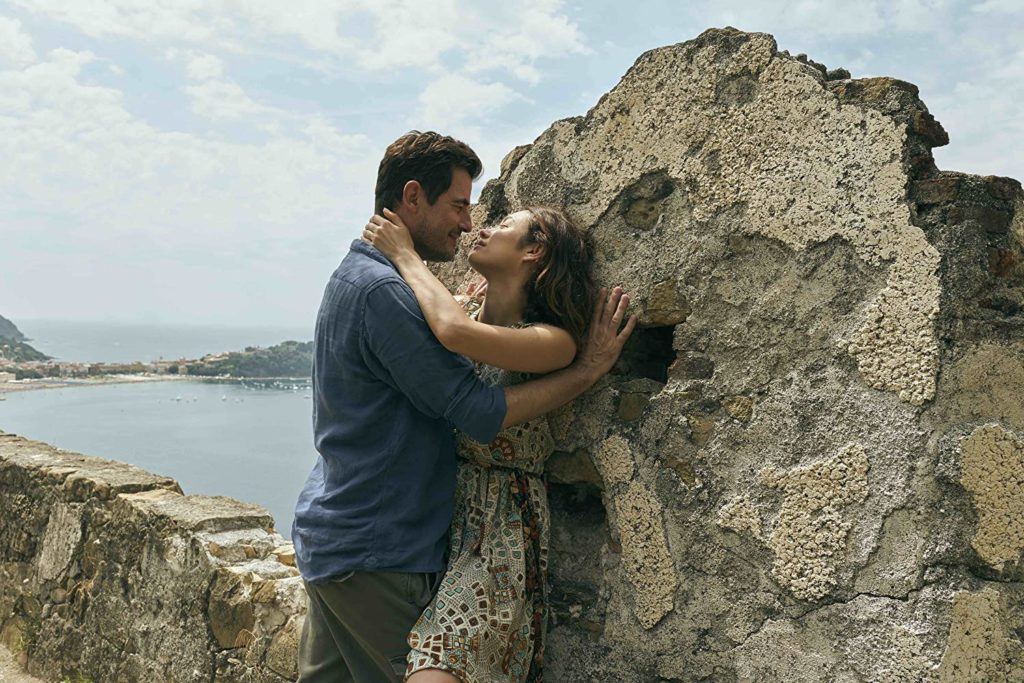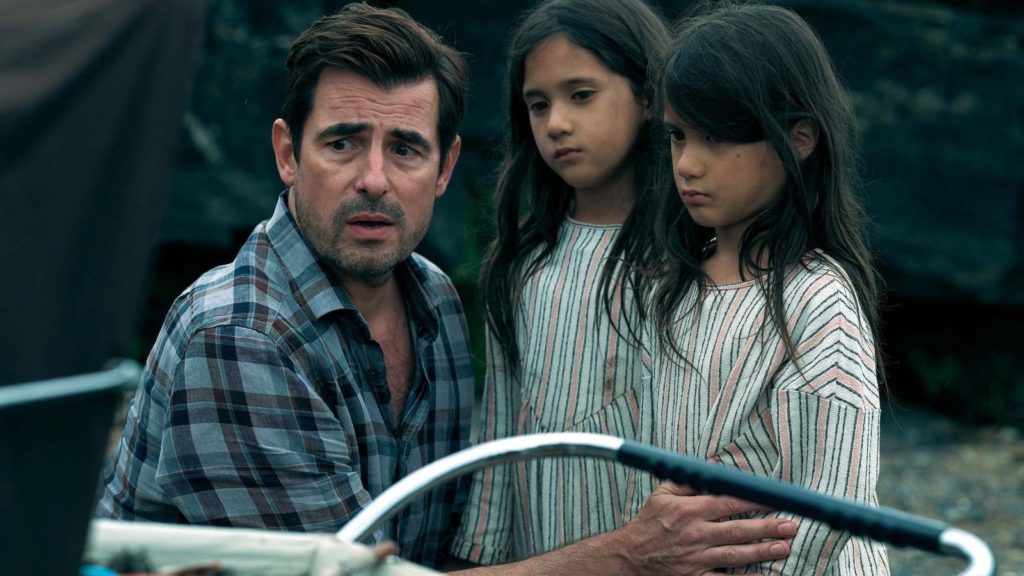THE BAY OF SILENCE is anything but silent. A mesmerizing and intriguing tale of secrets, lies, and love, THE BAY OF SILENCE speaks volumes thanks to a solid screenplay by Caroline Goodall (who also serves as a boots-on-the-ground producer), rich and telling cinematography and production design, riveting performances, and the beautifully executed vision of director Paula van der Oest. A real page-turner of a film that unlocks a mystery with intriguing breadcrumbs. Olga Kurylenko knocks your socks off as a woman descending into madness. Claes Bang soars. Brian Cox is delicious.

At its heart, THE BAY OF SILENCE is a love story; a love story between Will and his new wife Rosalind as he watches their once idyllic life begin to unravel following the birth of their son, a love story shrouded in mystery and suspicion. With an obvious declining mental state, Rosalind soon disappears with their infant son and her two daughters (who now adore Will) from a prior relationship, driving Will to find out not only where they have gone, but why; why is Rosalind so tortured, so broken, and what happened to push her over the edge like this. Digging into her past, Will starts to uncover secrets that someone has gone to great lengths to keep hidden, but what he initially discovers is not enough to prevent the death of his son, a death for which Rosalind is the prime suspect. Unwavering in his love, Will will stop at nothing to get to the root of Rosalind’s problems, even if it means finding the key and opening the Pandora’s box of the past to free her.

Adapted by Goodall from Lisa St. Aubin de Teran’s novel of the same name, standout is the structure of this thriller mystery. Replete with some surprising twists and turns, clues are doled out in little bits as we watch this story unfold from the perspective of Claes Bang’s Will. We, as an audience, are as much in the dark as he is, something that is not only appreciated as a viewer but surprising to see in this day and age where the audience so often is being given information the characters on screen do not have. We learn and see as Will does, making the film extremely engrossing, immersing us in the story, in their lives, and in Will’s Sherlockian pursuits.
Shot on location in Italy, director Paula van der Oest and cinematographer Guido van Gennep not only deliver a film showcasing the beauty and wonder of the European locales, particularly the Bay of SIlence itself in Liguria, Italy, but the locations play into the story structure and become characters in their own right. Particularly effective as storytelling tools are flashbacks. Snippets of moments rather than lengthy expository flashbacks but for one black & white climactic vision in the third act, these “Kodak moments” are vibrantly shown rather than the oft expected faded or sepia-toned imagery we normally associate with this technique. By opting for this vibrancy, van der Oest tacitly tells us that each moment is still as fresh, biting, and new as if it happened yesterday; the pain or the memory has not faded in the least.

As Will, Claes Bang is incredible as a family man and father. We have not seen this from him before and he is wonderful; warm, happy, encouraging, paternal, just childish enough to elicit kid giggles while still being “dad” with the twin girls and with baby Amadeo. But then there’s Olga Kurylenko. I don’t recall seeing her in a role with no make-up or natural look such as this, but here as Rosalind she is fresh, youthful, unfettered – almost a 60’s free love kind of vibe to her. And then you put the two of them together. Effortless ease. Van der Oest wastes no time in setting the stage with Will and Rosalind, establishing the chemistry between Bank and Kurylenko early on in Liguria. Watching them in this setting is pure heaven, also due in large part to van Gennep’s lensing which metaphorically speaks to the exciting and passionate new love blossoming. The bay and the town are beyond charming and serve as characters in this story. And the water, the bay itself, is almost baptismal which, as we see the film play out, metaphorically cleanses the sins and secrets of the past. (Or does it?) There is almost a fairytale feel to the beauty and unfolding love between Will and Rosalind.
But, as we all know, the best fairytales – such as those of the Grimm Brothers – are actually quite dark, and this fairytale of Will and Rosalind certainly heads down the rabbit hole of darkness rather quickly. . . and it starts with Roz and the birth of Amadeo. What she suffers from is obviously much more than post-partum depression. We start to see her change as she goes from porcelain fresh-faced to sallow and hollow-cheeked with dark dark circles and sunken hollowness around the eyes; an almost decaying skeletal look that matches her mental decay. And we have Will, loving and supportive but confused. Watching Kurylenko at Bel Reve by the sea as Rosalind suffers a complete psychotic break is stunning. Believable, frightening, heartbreaking. And it compels you almost to the point of obsession to know more, to know what has driven her to this.

Goodall plants enough tiny breadcrumbs that if one is astute, the trail to the past starts manifesting early on. We see Rosalind taking pills of some sort, hiding it from Will. We hear her step-father Milton constantly brag about his days in the intelligence community, but bragging almost like a veiled threat thanks to vocal nuance as only Brian Cox can bring to the fore. Expensive exquisite gifts of jewelry are presented to Rosalind at a post-birth baby party for Amadeo. Wads of cash and forged papers appear following the death of Amadeo. Candy the nanny disappears at a most precipitous moment during Rosalind’s period of disappearance. Key plot points? MacGuffins? All fuels suspicion and ambiguity immersing one ever deeper in this tale.
And then there are Rosalind’s twin daughters from her prior relationship. After disappearing with their mother, we next see them alone together on the rocky shores of Bel Reve dressed alike in striped ill-fitting dresses, demanding to push the baby carriage together, positioned shoulder to shoulder in multiple shots. It was like looking at the creepy twins in The Shining. But, it plays well in creating ambiguity where baby Amadeo is concerned. Did the girls throw him in the ocean? Smash his head on the rocks? Jealous a bit? Beautifully set-up from a structural standpoint that is only enhanced by van Gennep’s lensing, particularly with camera dutching, complemented further by exemplary sound design that fills the aural space with the crash of waves on the rocks.

But it is the scenes with Cox as Milton that take THE BAY OF SILENCE to the next level. Already engrossed in the noir-ish thriller and compounding mysteries, not only do we relish Milton’s maniacal machinations thanks to Cox’ performance, but they propel the story and the revelatory cause and effect within. It is also a climactic scene with Cox and Bang that fully showcases the talents of production designer Harry Ammerlaan as his design of a room within Milton’s house speaks volumes, defining characters, melding the past and the present. Glass and mirror pieces, all strung together like windchimes or a wall of windchimes, is perfection, metaphorically serving as fractured pieces of personalities. Fractured pieces of life. The reflection as they move thanks to a soft breeze coming through a window with light bouncing off each piece is gorgeous. Dutched camera angles further speak to surrounding psychoses. Sheer organza draperies behind Milton, backlit so we see shadows behind him and that cool cool, icy whisper of aqua matching the color of the paint on the wall dazzles. Standout is a painting hanging in the hallway which we see as Will enters the room; a tiger lying in wait, ready to pounce or lick his chops at his next tasty meal. Divine. The orchestration of that scene is also spectacularly done with sound design – the tinkling of the mirrors and glass, a gunshot, barely discernible footsteps. Kudos to supervising sound editor Alex Booy and his team. Then add in false frames of reflection as to the smoking gun and who fired it. Perfectly cut and paced by editors Paul Tothill and Sandra Vos, this entire sequence is an exemplary example of a fully sensory nail-biting experience, something that has been building to this boiling point since the beginning of the film.

Completing the picture is a fresh and easy score by John Swihart.
Bookending the film at the Bay of Silence itself brings the story full circle. Embracing metaphor one last time, van der Oest leaves us to our own devices, our own mystery-solving skills, begging the question, even when uncovered, are secrets ever fully revealed. The answer? As Rosalind says, “Shhh. We are in the Bay of Silence.”
Directed by Paula van der Oest
Written by Caroline Goodall adapted from the novel by Lisa St. Aubin de Teran
Cast: Claes Bang, Olga Kurylenko, Brian Cox
by debbie elias, 08/01/2020












